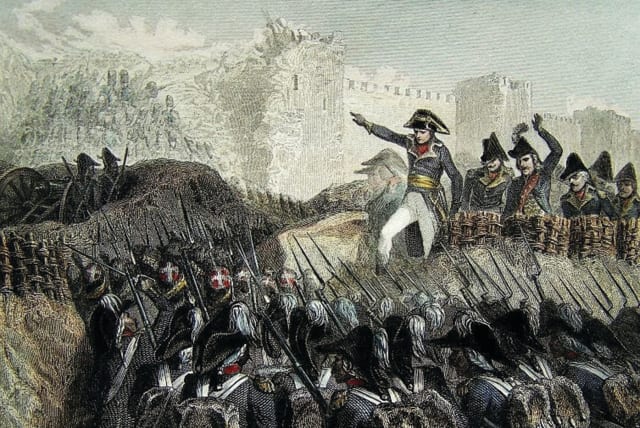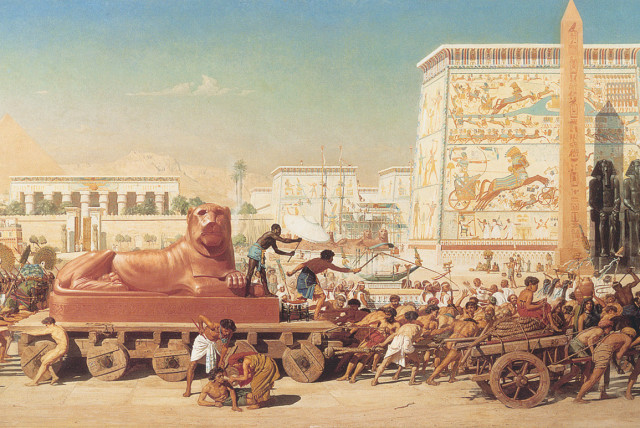24 biblical, historical events that happened in the Hebrew month of Nissan

Of the 12 stones on the High Priest's ephod (breastplate), the stone for Nissan is known as “nophech” and is identified with a turquoise or blue emerald.
According to the Talmud, the world was created in Nissan. The month is referred to as the “first month,” “the month of ripened barley” (due to the barley harvest), “Nissan” (a Babylonian name), and “hodesh ha’aviv,” the month of spring.
Of the 12 stones on the ephod (breastplate) of the Cohen High Priest, the stone for Nissan is known as “nophech” and identified with turquoise or blue emerald.
A selection of 24 Nissan-related events follows.
24 events related to the Hebrew month of Nissan
- 1743 BCE God made a covenant with Abraham, bequeathing the Land of Israel to his descendants as their eternal heritage – after experiencing exile and persecution. “And He said to Avram: ‘Know surely that your descendants shall be strangers in a land that is not theirs, and they will be enslaved to them, and they will afflict them four hundred years... and afterward they shall come out with great wealth.’ On that day G-d made a covenant with Avram, saying: ‘To your seed I have given these lands, from the river of Egypt to the great river, the River Euphrates’” (Genesis 15:13-18).
- 1713 BCE According to Seder Olam 5, on the 3rd day following his circumcision at age 99, angels appeared to inform Avraham that a son would be born to Sarah exactly a year from then. (Genesis 18:10).

- 1712 BCE Birth of Isaac to Avraham and Sarah. (Genesis 21:1-6, Talmud in Rosh Hashanah 10b). Our forefathers Abraham and Jacob were also born in Nissan.
- 1556 BCE On his journey back to Israel, Jacob wrestled with an angel all night until dawn. The angel then blessed Jacob and changed his name to Israel, “for you have contended with God and with men, and have prevailed.” (Genesis 32:25-29)
- 1314 BCE One year before the Exodus, Moses was shepherding the flocks of his father-in-law, Jethro, at the foot of Mount Sinai, when God appeared to him in a “thorn bush that burned with fire but was not consumed” (Exodus 3:2). After arguing for seven days, Moshe finally accepted his mission to return to Egypt to redeem the people of Israel and bring them to Sinai.
- 1313 BCE Two weeks before the exodus from Egypt (Exodus 12:2), God instructed Moses regarding the lunar months of the Jewish calendar and taught the mitzvah of sanctifying the new month. “This month shall be for you the head of months, the first of the months of the year.”
- 1312 BCE The Tabernacle was erected in the desert (Exodus 40:2) and the heads of the Tribes brought their offerings for the dedication of the altar.
- 1274 BCE Miriam the prophetess (sister of Moshe and Aharon) died at the age of 126, and according to Seder Olam 10, the mobile well, which had supplied water to the Jews in the desert in her honor, dried up. (Numbers 20).
- 1273 BCE The Israelites, led by Joshua, crossed the Jordan River, which split for them and they enteried the Promised Land (Joshua 4:20).
- 701 BCE The Assyrian army of Sennacherib, which had threatened Jerusalem, was destroyed (2 Kings 19:35, 2 Chronicles 32:21).
- 538 BCE Nissan marked the beginning of the return to the Land of Israel from the Babylonian exile under Ezra and Nehemiah (Ezra 7:9). The latter received permission to rebuild Jerusalem and its walls on the first of Nissan (Nehemiah 2:1).
- 372 BCE Daniel, a “wise and righteous” man living in the Babylonian, was cast into a lions’ den by Darius I of Persia for violating the royal edict forbidding prayer to any “god” other than the king. The lions did not touch him, and he emerged unscathed (Daniel 6:5-29).
- 357 BCE A decree was dispatched to all 127 countries of the Persian Empire “to destroy, kill and annihilate all Jews, from young to old, infants and women, on a single day.” (Esther 3:12). Esther ordered a three-day fast – including the first two days of Passover – for all the Jews of Shushan to pray for the success of her mission to go before the king and plead for her people (Esther 4:16).
- 1516 When the Jews of Venice were forced to move into a restricted area, the term “ghetto” was first applied to a Jewish quarter.
- 1556 By order of the Pope, Portuguese forced converts who had returned to Judaism were burned in Ancona, Italy. This led Jewish businesswoman and philanthropist Dona Gracia Nasi to spearhead a boycott against the port of Ancona, marking the first concerted drive by the free Jewish communities to hit back at their enemies.
- 1575 Death of Rabbi Yosef Caro, student of “the Ari” (R. Yitzhak Luria) and compiler of the Shulhan Aruch (a project that took 32 years), marking the end of the period of the early commentators, “Rishonim,” and the beginning of the era (still ongoing) of the later commentators, known as “Aharonim.”
- 1799 During his siege of Acre, Napoleon issued a proclamation to the Jews of Palestine promising the “reestablishment of ancient Jerusalem,” coupled with a plea for their support. This was the first promise by a modern government to establish a Jewish state.
- 1866 Rabbi Menachem Mendel of Lubavitch, the third Rebbe of Chabad and author of Tzemach Tzedek passed away.
- 1897 The first issue of the Jewish Daily Forward, a daily Yiddish newspaper, was published in New York City.
- 1923 Shlomo Hillel was born in Baghdad. He later returned to Iraq as a Mossad agent in 1950 to help organize the mass airlift of 120,000 Iraqi Jews to Israel, known as Operation Ezra and Nehemiah. Later he served as a member of Knesset, a minister, speaker of the Knesset speaker, and Israeli ambassador to several African countries.
- 1924 Birth of Joseph Gerber, Austrian inventor who escaped to the US and patented: 1) the Gerber Variable Scale which was called “the most revolutionary engineering tool since the slide rule”; 2) the world’s first digital drafting machine, or “photoplotter,” which was used in over 75% of the television circuit boards manufactured in the 50s; 3) the Gerbercutter S-70, a fully automated cloth-cutting system, credited with saving the US clothing industry in the late 1960s, 4) the computer-assisted equipment in the ‘80s that allowed opticians to produce eyeglasses in about an hour.
- 1928 birth of Cynthia Ozick, award-winning American short story writer, novelist, and essayist, described as “one of the most accomplished and graceful literary stylists of her time.
- 1932 birth of Elaine May, American satirical comedian, film director, screenwriter, and actress. She received the National Medal of Arts in 2013 for her “keen understanding of how humor can illuminate our lives.”
- 1969 Death of Reb Aryeh Levin, known as “Father of the Prisoners.” Ordained by Rabbis Chaim Berlin and Shmuel Salant, Levin devoted himself to volunteer work at the leper hospital and prison in Jerusalem, considering those jailed by the British his special mission. Levin consistently refused all honors, choosing to live in near poverty in the Mishkenot section of Jerusalem. ■
This list was compiled thanks to Dust and Stars dustandstars.substack.com
